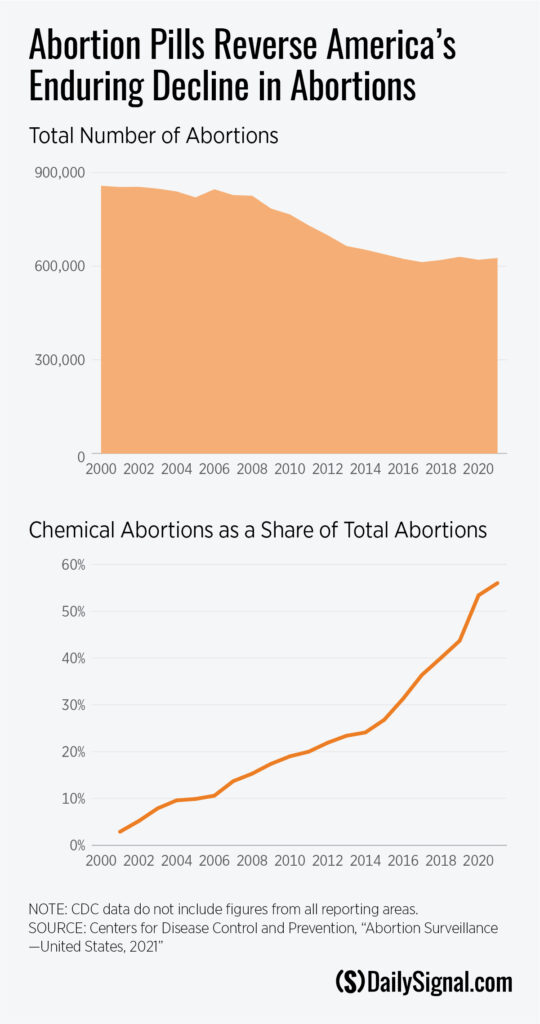The most recent report on abortion from the Centers for Disease Control and Prevention is out and, as usual, it’s grim.
The number of abortions rose from 620,327 in 2020 to 625,978 in 2021. The key drivers in this depressing increase are a greater use of dangerous chemical abortion pills and weakened safety protocols governing the use of such pills.
We can expect to see some big changes next year, when the CDC releases numbers for 2022 numbers (as some states already have done).
Why? Last summer, the Supreme Court righted a grave wrong and overturned Roe v. Wade and abortion on demand with its ruling in the case known as Dobbs v. Jackson Women’s Health Organization. More than a dozen states quickly enacted strong pro-life laws protecting women and unborn children.
Knowing that 2022 data will reflect post-Roe policy changes at the state level, it could be tempting to write off the 2021 numbers as “old news.” But that would be a mistake. Abortion pills aren’t just the key driver behind the rise in abortions in recent years. The pills are also among the biggest threats to pro-life progress in post-Roe America.
Let’s dive into the data. Some important caveats: The numbers don’t show the whole picture because there’s no national reporting standard. Each state collects data a little differently, and reporting isn’t mandatory (California, New York, New Hampshire, and New Jersey don’t report anything at all).
However, the CDC data is still helpful in seeing overall trends.

At first glance, you can see the decline in the total number of abortions in the past two decades: 857,475 in 2000 but dropping to 625,978 in 2021.
For many years, the number of abortions went down each year. But after hitting a low in 2017, the number has been ticking up again. Chemical abortion is largely to blame.
Let’s take a closer look.
Abortion pills were approved by the U.S. Food and Drug Administration in fall 2000. In 2001, chemical abortions were a mere 3% of all abortions. But in 2021, that number skyrocketed to 56% of abortions.
From 2001 to 2016, there was a steady increase in the percentage of abortions that were chemical in nature. After that, though, the percentage of chemical abortions began climbing fast.
There’s a simple reason for this: lax safety rules. Under the original FDA approval, abortion pills could be taken as late as 49 days of gestation, or seven weeks. The pills also had to be prescribed by a physician and dispensed in person, and multiple in-person visits for examination and follow-up were required.
In 2016, the FDA updated these longstanding safety protocols. Pills could be taken up as late as 70 days of gestation (10 weeks), health care practitioners other than physicians could prescribe them, and although the pills had to be dispensed in person, later in-person follow-ups no longer were required.
These changes made dangerous abortion pills far more accessible.
Then, in early 2021, under the guise of containing the spread of COVID-19, the Food and Drug Administration dropped the rule that these dangerous drugs must be dispensed in person. Suddenly, the pills could be shipped through the mail.
Later in 2021, the FDA announced that it would make this change permanent and set up a process for retail pharmacies, such as Walgreens and CVS, to distribute abortion pills too.
The 2021 data doesn’t fully reflect those latest changes, but we’ll see what happens when the CDC’s 2022 data comes out next year. Importantly, that data will reflect the post-Roe landscape in which a dozen states moved to fully protect life.
We can hope for some good news. One study finds that 32,000 lives have been saved so far since the high court’s ruling. But pro-abortion states, the abortion industry, and its allies in the Biden administration will rely on abortion pills to undermine the pro-life state laws.
How can pro-life states fight back? They must enforce existing laws to prevent do-it-yourself mail-order abortion pills.
Federal policymakers also must work to protect women and unborn children from these dangerous drugs. They have a chance to do so not just through a stand-alone bill to nullify the FDA changes, but through the appropriations process.
While we wait for more recent numbers, the CDC’s 2021 abortion data should remind us of the stakes. These abortion numbers represent thousands of irreplaceable human beings whose lives were violently ended by abortion. Building a culture of life requires changing laws, but it also requires changing hearts and minds.
Let’s hope that the babies who get to celebrate a birthday thanks to the Supreme Court’s Dobbs decision can help do just that.
This piece originally appeared in The Daily Signal




